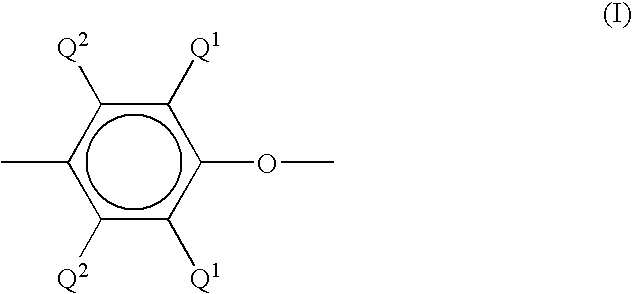High flow compositions of compatibilized poly(arylene ether) polyamide blends
- Summary
- Abstract
- Description
- Claims
- Application Information
AI Technical Summary
Benefits of technology
Problems solved by technology
Method used
Image
Examples
examples 1-14
[0054] Examples 1 and 8 are comparative examples and contain no dendritic polyester Examples 1-14 the polyamide was added in two parts, 10.0 wt % was added in The first feeder and the remainder 31.3 wt % was added in a second feeder. In examples 2-7 the dendritic polyester resin was added in the first feeder. In examples 9-14 the dendritic polyester resin was added in the second feeder. Melt flow rate was determined by measuring the average mass of melt polymer that flowed through an orifice over a period of 10 minutes (ASTM D1238). Results are shown in Table 2.
[0055] [t2]
2TABLE 2 Amount of dendritic Example polyester resin Melt Flow Rate 1* 0 0.78 2 0.5 1.83 3 1.0 2.5 4 1.5 4.7 5 2.0 6.01 6 3.0 11.93 7 4.0 -- 8* 0 0.78 9 0.5 1.07 10 1.0 2.48 11 1.5 3.4 12 2.0 5.51 13 3.0 9.48 14 4.0 16.33 *Comparative example
[0056] As can be seen by Examples 1-14, the inclusion of a small amount of dendritic polyester resin results in a large increase in the melt flow rate.
examples 15-20
[0057] Example 15 is comparative example and contains no dendritic polyester resin. Examples 16-20 contain varying amounts of dendritic polyester resin as shown in Table 3. In Examples 16-18 the dendritic polyester resin was added in the first feeder. In Examples 19 and 20 the dendritic polyester resin was added in the second feeder. The material was molded and tested. The results are shown in Table 3. Heat distortion temperature was determined according to ASTM D648 on 0.125 inch (3.175 millimeters) samples at 66 pounds per square inch (psi) (0.4 Mega Pascals). Notched by any Izod was determined according to ASTM D256. DYNATUP.RTM. (falling dart) total energy, energy to maximum load, and energy to failure were measured according to ASTM D3763. Flexural modulus and flexural strength were determined according to ASTM D790. Tensile strength at yield, tensile strength at break and tensile elongation at break were determined by ASTM D638.
[0058] [t3]
3 TABLE 3 Example Property 15* 16 17 1...
PUM
| Property | Measurement | Unit |
|---|---|---|
| Percent by mass | aaaaa | aaaaa |
| Percent by mass | aaaaa | aaaaa |
| Percent by mass | aaaaa | aaaaa |
Abstract
Description
Claims
Application Information
 Login to View More
Login to View More - R&D
- Intellectual Property
- Life Sciences
- Materials
- Tech Scout
- Unparalleled Data Quality
- Higher Quality Content
- 60% Fewer Hallucinations
Browse by: Latest US Patents, China's latest patents, Technical Efficacy Thesaurus, Application Domain, Technology Topic, Popular Technical Reports.
© 2025 PatSnap. All rights reserved.Legal|Privacy policy|Modern Slavery Act Transparency Statement|Sitemap|About US| Contact US: help@patsnap.com

